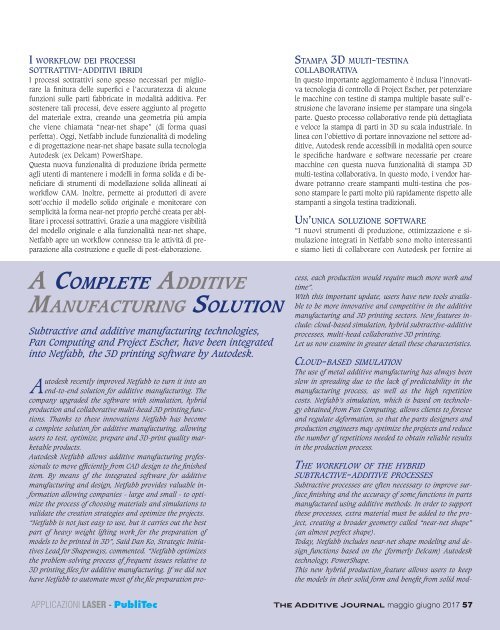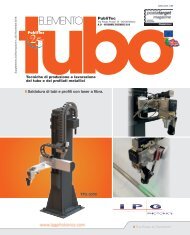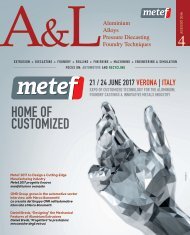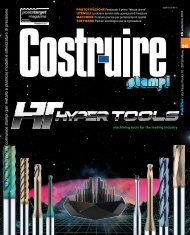Sfogliabile_Applicazioni_Laser_maggio_57
You also want an ePaper? Increase the reach of your titles
YUMPU automatically turns print PDFs into web optimized ePapers that Google loves.
i workflow dei proceSSi<br />
Sottrattivi-additivi ibridi<br />
I processi sottrattivi sono spesso necessari per migliorare<br />
la finitura delle superfici e l’accuratezza di alcune<br />
funzioni sulle parti fabbricate in modalità additiva. Per<br />
sostenere tali processi, deve essere aggiunto al progetto<br />
del materiale extra, creando una geometria più ampia<br />
che viene chiamata “near-net shape” (di forma quasi<br />
perfetta). Oggi, Netfabb include funzionalità di modeling<br />
e di progettazione near-net shape basate sulla tecnologia<br />
Autodesk (ex Delcam) PowerShape.<br />
Questa nuova funzionalità di produzione ibrida permette<br />
agli utenti di mantenere i modelli in forma solida e di beneficiare<br />
di strumenti di modellazione solida allineati ai<br />
workflow CAM. Inoltre, permette ai produttori di avere<br />
sott’occhio il modello solido originale e monitorare con<br />
semplicità la forma near-net proprio perché creata per abilitare<br />
i processi sottrattivi. Grazie a una <strong>maggio</strong>re visibilità<br />
del modello originale e alla funzionalità near-net shape,<br />
Netfabb apre un workflow connesso tra le attività di preparazione<br />
alla costruzione e quelle di post-elaborazione.<br />
Stampa 3d multi-teStina<br />
collaborativa<br />
In questo importante aggiornamento è inclusa l’innovativa<br />
tecnologia di controllo di Project Escher, per potenziare<br />
le macchine con testine di stampa multiple basate sull’estrusione<br />
che lavorano insieme per stampare una singola<br />
parte. Questo processo collaborativo rende più dettagliata<br />
e veloce la stampa di parti in 3D su scala industriale. In<br />
linea con l’obiettivo di portare innovazione nel settore additive,<br />
Autodesk rende accessibili in modalità open source<br />
le specifiche hardware e software necessarie per creare<br />
macchine con questa nuova funzionalità di stampa 3D<br />
multi-testina collaborativa. In questo modo, i vendor hardware<br />
potranno creare stampanti multi-testina che possono<br />
stampare le parti molto più rapidamente rispetto alle<br />
stampanti a singola testina tradizionali.<br />
un’unica Soluzione Software<br />
“I nuovi strumenti di produzione, ottimizzazione e simulazione<br />
integrati in Netfabb sono molto interessanti<br />
e siamo lieti di collaborare con Autodesk per fornire ai<br />
a complete additive<br />
maNufacturiNg solutioN<br />
Subtractive and additive manufacturing technologies,<br />
Pan Computing and Project Escher, have been integrated<br />
into Netfabb, the 3D printing software by Autodesk.<br />
Autodesk recently improved Netfabb to turn it into an<br />
end-to-end solution for additive manufacturing. The<br />
company upgraded the software with simulation, hybrid<br />
production and collaborative multi-head 3D printing functions.<br />
Thanks to these innovations Netfabb has become<br />
a complete solution for additive manufacturing, allowing<br />
users to test, optimize, prepare and 3D-print quality marketable<br />
products.<br />
Autodesk Netfabb allows additive manufacturing professionals<br />
to move efficiently from CAD design to the finished<br />
item. By means of the integrated software for additive<br />
manufacturing and design, Netfabb provides valuable information<br />
allowing companies - large and small - to optimize<br />
the process of choosing materials and simulations to<br />
validate the creation strategies and optimize the projects.<br />
“Netfabb is not just easy to use, but it carries out the best<br />
part of heavy weight lifting work for the preparation of<br />
models to be printed in 3D”, Said Dan Ko, Strategic Initiatives<br />
Lead for Shapeways, commented. “Netfabb optimizes<br />
the problem-solving process of frequent issues relative to<br />
3D printing files for additive manufacturing. If we did not<br />
have Netfabb to automate most of the file preparation process,<br />
each production would require much more work and<br />
time”.<br />
With this important update, users have new tools available<br />
to be more innovative and competitive in the additive<br />
manufacturing and 3D printing sectors. New features include:<br />
cloud-based simulation, hybrid subtractive-additive<br />
processes, multi-head collaborative 3D printing.<br />
Let us now examine in greater detail these characteristics.<br />
Cloud-based simulation<br />
The use of metal additive manufacturing has always been<br />
slow in spreading due to the lack of predictability in the<br />
manufacturing process, as well as the high repetition<br />
costs. Netfabb’s simulation, which is based on technology<br />
obtained from Pan Computing, allows clients to foresee<br />
and regulate deformation, so that the parts designers and<br />
production engineers may optimize the projects and reduce<br />
the number of repetitions needed to obtain reliable results<br />
in the production process.<br />
the workflow of the hybrid<br />
subtraCtive-additive proCesses<br />
Subtractive processes are often necessary to improve surface<br />
finishing and the accuracy of some functions in parts<br />
manufactured using additive methods. In order to support<br />
these processes, extra material must be added to the project,<br />
creating a broader geometry called “near-net shape”<br />
(an almost perfect shape).<br />
Today, Netfabb includes near-net shape modeling and design<br />
functions based on the (formerly Delcam) Autodesk<br />
technology, PowerShape.<br />
This new hybrid production feature allows users to keep<br />
the models in their solid form and benefit from solid mod-<br />
APPLICAZIONI LASER - PubliTec<br />
The Additive Journal <strong>maggio</strong> giugno 2017 <strong>57</strong>





